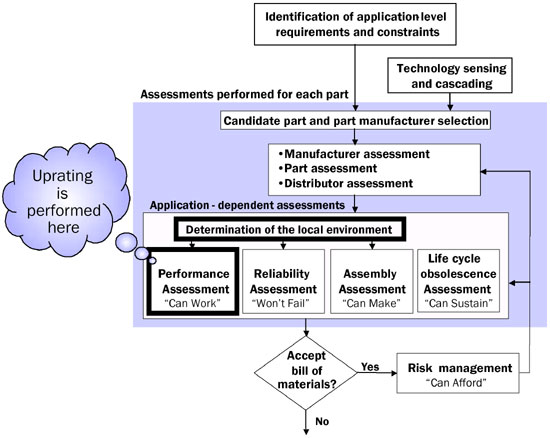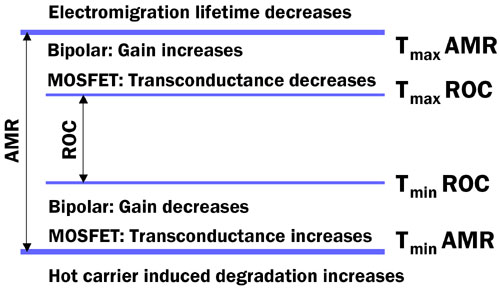Introduction
Semiconductor parts are most often specified for use in the “commercial” 0 to 70°C and, to a lesser extent, in the “industrial” -40 to 85°C operating temperature range. These operating temperature ratings generally satisfy the demands of the dominant semiconductor customers in the computer, telecommunications, and consumer electronic industries. There is also a demand for parts rated beyond the “industrial” temperature range, primarily from the aerospace, military, oil and gas exploration, and automotive industries. However, the demand has not been large enough to attract or retain the interest of major semiconductor part manufacturers to make these parts. In fact, wide temperature range parts are becoming obsolete and functionally equivalent parts are not replacing them.
Uprating: Today’s Need?
Today, for some applications, it is difficult to procure parts that meet engineering, economic, logistical, and technical integration requirements of product manufacturers, and that are rated for an extended temperature range (typically beyond 0 to 70°C). There are products to be supported and new products to be built which require parts that can operate at temperatures beyond the “industrial” temperature range. In some applications, the functionality of the product requires that parts with the latest technology and packaging style be used. These parts are often available only in the “commercial” temperature range. If the product application environment is outside the commercial range, steps must be taken to address this apparent incompatibility. For example, oil exploration and drilling applications require small, advanced communication electronics to work underground at high temperatures where cooling is not possible. This is where uprating comes into play. Uprating is defined as a process to assess the capability of a part to meet the functionality and performance requirements of the application in which the part is used outside the manufacturers’ specification range [1].
Today, the use of uprated parts is common in many industries. For example, uprated parts are used in telecommunication systems and in flight management and engine control systems. The Boeing 777 uses many uprated parts for its avionics. Even industries such as home appliance or personal computing are facing the need to uprate parts. To mitigate the risks involved in the process, uprating should be performed within the realm of the part selection and management process as shown in Figure 1 [2], [3].
 |
Figure 1. Uprating in the electronic parts selection and management process.
Why Is Uprating Possible?
Often there is little difference between parts rated for the various commercial, industrial or even military temperature ranges. In fact, many electronic parts manufacturers have used the same die for various “grades” of parts (commercial, industrial, automotive, and military). For example, Intel [4] stated in their military product data book: “There is no distinction between commercial product and military product in the wafer fabrication process. Thus, in this most important part of the VLSI manufacturing process, Intel’s military products have the advantages of stability and control which derive from the larger volumes produced for commercial market. In the assembly, test and finish operations, Intel’s military product flow differs slightly from the commercial process flow, mainly in additional inspection, test and finish operations.” (Author’s Note: Intel has stopped supplying military parts. The last order date was 12/24/97. However, the statement made by them is still valid in terms of the practice by various manufacturers.)
A review of the reasons why many electronic part manufacturers have discontinued the production of military parts points to business as opposed to technical reasons. For example, when AMD left the military parts business in 1994, it stated “AMD has positioned itself to be a leader in the development and manufacture of integrated circuits for the personal and networked computation and communication sectors. To support this strategy, the decision has been made to begin the active disengagement from the manufacture of military products.” There was no lack of technical expertise in producing the wide temperature range parts but the business plans for the future did not see a significant profit in making such parts.
There is typically a margin between the operating temperature specification of a part and the temperature range over which the part can actually operate reliably. Manufacturers usually provide a margin for this. Margins exist between the specified operating temperature limits and the actual operating capability of the parts. These help to maximize part yield, reduce or eliminate outgoing tests and optimize sample testing and statistical process control. Mature wafer process lines that produce parts in high volume result in electrical parameters within a narrow band. The only difference between the different temperature rated parts appears to be the additional verification testing of the wider temperature range parts (exploiting the enhanced capability of the robust process). Parts that belong to a robust process with enhanced capability are likely to be able to perform and provide stable and predictable electrical parameters beyond their recommended operating conditions (ROC) ratings.
Absolute Maximum Ratings
The absolute maximum rating (AMR) section in the datasheet includes limits on operational and environmental parameters, including power, power derating, supply and input voltages, operating temperature, junction temperature, and storage temperature.
The International Electrotechnical Commission (IEC) [5] defines absolute maximum ratings as “limiting values of operating and environmental conditions applicable to any electronic device of a specific type as defined by its published data, which should not be exceeded under the worst possible conditions. These values are chosen by the device manufacturer to provide acceptable serviceability of the device, taking no responsibility for equipment variations, and the effects of changes in operating conditions due to variations in the characteristics of the device under consideration and all other electronic devices in the equipment. The equipment manufacturer should design so that, initially and throughout life, no absolute-maximum value for the intended service is exceeded with any device under the worst probable operating conditions with respect to supply voltage variation, equipment component variation, equipment control adjustment, load variations, signal variation, environmental conditions, and variation in characteristics of the device under consideration and of all other electronic devices in the equipment.” In other words, the part manufacturers select the AMR values, and the companies, which integrate electronic parts into products and systems, are responsible for assuring that the AMR conditions are not exceeded.
Recommended Operating Conditions (ROC)
Recommended operating conditions provided by part manufacturers include voltage, temperature ranges, input rise and fall time. Part manufacturers guarantee the electrical parameters (typical, minimum, and maximum) of the parts only when they are used within the recommended operating conditions and standard operating conditions. Philips notes, “The recommended operating conditions table [in the Philips datasheet] lists the operating ambient temperature and the conditions under which the limits in the “DC characteristics” and “AC characteristics” will be met” [6]. Philips also states that “The table (of recommended operating conditions) should not be seen as a set of limits guaranteed by the manufacturer, but the conditions used to test the devices and guarantee that they will then meet the limits in the DC and AC characteristics table.”
ZiLOG [7] states, “Recommended operating conditions are given so customers know the maximum and minimum conditions where normal performance is still available from the device. Once the normal operating conditions are exceeded, the performance of the device may suffer.”
Associating ROC to Reliability
Reliability is the ability of a part to perform within specified performance limits, for a specified period of time, under the life cycle application conditions [8]. Reliability assessment can be performed independent of the performance assessment step (where uprating may be carried out), because the recommended operating conditions that are stated in the part datasheet are associated only to the electrical parameter limits.
It has been observed that the manufacturer’s part qualification process is not based on the part’s temperature ratings. The part operating temperature ratings are set for performance reasons as opposed to reliability reasons. Part qualification and periodic integrity monitor testing temperature ranges and durations (for tests such as High Temperature Operating Life Test [HTOL], Low Temperature Operating Life Test [LTOL], High Temperature Storage Test [HTS], Temperature Cycle Test [TC], Temperature Humidity Bias Test [THB], Highly Accelerated Stress Test [HAST]) are performed for wafer family and package types. The same temperatures and temperature ranges are used for testing the parts that are sold for various temperature ranges.
Part manufacturers have different opinions on using a part between ROC and AMR limits. Some part manufacturers state that the performance of the part is not guaranteed above the recommended operating conditions. However, they mention that using a part between ROC and AMR does not affect its useful life. These manufacturers do not correlate performance to reliability between ROC and AMR limits of parts. Some manufacturers (e.g., Motorola) just state that operating parameters within the recommended operating range are not guaranteed at or near the AMR without a direct reference to reliability. But they add that if the part is used over a long period, they have reliability concerns for useful life [9].
Associating AMR to Part Performance
The part manufacturers provide absolute maximum ratings as limits for reliable operation. Electrical performance of the parts is not related to the AMR conditions. No part manufacturer guarantees the electrical performance at or beyond the AMR. Part manufacturers derive AMRs on parameters as guidance for designers. These values help designers in determining whether the part applications are compatible with anticipated worst-case stress conditions in the equipment. All concerns regarding AMR relate only to the reliability and physical failures of the parts.
ZiLOG [7] states, “AMRs (Absolute Maximum Ratings) are given to allow our customers to understand at what point physical damage can occur to the device under stress. Once the operating conditions exceed the AMR, damage may ensue.” Philips comments, “The ‘RATINGS’ table (Limiting Values in Accordance with the Absolute Maximum System – IEC 134) lists the maximum limits to which the device can be subjected without damage. This doesn’t imply that the device will function at these extreme conditions, only that, when these conditions are removed and the device operated within the recommended operating conditions, it will still be functional and its useful life won’t have been shortened [6].”
Summary
The relationship between AMR and ROC and ideally how they relate to the physical aspects of a part performance and use is explained in Figure 2. The figure is used for illustration only; the specific logics and the process used vary between companies that produce the parts.
 |
Figure 2. Schematic representation of ROC and AMR in relation to performance and reliability.The thought process in developing the recommended operating conditions rating relates to the electrical parameter variation with temperature. The word “performance” relates to adherence of the electrical parameters according to datasheet specifications. For example, the gain of a bipolar transistor decreases with an increase in temperature and for a CMOS transistor; the transconductance increases with a decrease in temperature. The semiconductor physics dictates the changes in electrical parameters with temperature and the part manufacturers determine the limits through testing of parts and provide the guaranteed parameter limits in their datasheets. When the temperature is beyond the ROC (above or below), the parameter limits may go beyond the manufacturer specified limits.
Since the effect of temperature on device parameters depends upon the type of part and the processing technology, we do see that in some occasions, the part manufacturers change the parameter limits within ROC with a change in processing. For example, Texas Instruments had modified the maximum supply current limit for the UC2950 part from 30 mA to 36 mA when they changed a fabrication plant [10]. TI states that “the supply current is running higher because the reference zener diode used in the new wafer fabrication plant (SFAB) has a higher breakdown voltage than the zener diode breakdown voltage from the old wafer fabrication plant (MFAB) – hence the bias currents running from it are higher.” There is no reference to or implication of this change on the reliability of the part.
Analogously, the AMR conditions relate to the failure mechanisms by which parts fail. At higher temperatures, the time to failure by electromigration decreases and the upper AMR limit may be determined taking the expected life under electromigration failure into consideration. Similarly, at low temperature, the rate of damage by hot carrier injection increases and the lower temperature limit at AMR can relate to the temperature below which the rate of damage accumulation by hot carrier injection becomes unacceptably high. A complete treatise on the effect of temperature on the failure mechanisms that affect semiconductor parts can be found in reference [11].
What Does a Part User Do?
The confirmation of ratings of electronic parts is the first step in deciding whether uprating is necessary or possible. The part ratings can be obtained from the datasheet. In spite of having some similarities, the datasheets from different companies vary in parameters, definitions, and level of details. This article focuses on two broad issues about the part ratings, AMR and ROC. This observation helps one to obtain some necessary information. For example, some manufacturers do not provide clear identification of ROC values in the datasheets. Some companies do not specify ROC tables in their datasheets, instead they give ROC ambient temperature ranges in the “ordering information” or “ordering guide” table (e.g., Analog Devices and Maxim Integrated Products). We can confirm this fact by querying the manufacturers about the temperature range for which they guarantee the electrical parameters. It is evident that there is no standard available for the part ratings. Therefore, it becomes difficult to compare parts of the same functionality from different manufacturers. It also requires extra effort from the user to contact manufacturers due to the unavailability of some ratings in the part datasheet.
The standardization of part ratings can facilitate the methodology of the part selection and management. However, under the current business model of most semiconductor companies, it is unlikely that the manufacturers are going to heed such a call for standardization. (Author’s Note: Several JEDEC standards on the contents of a part datasheet exist. In the past, there had also been standards relating to part datasheet descriptions for specific product types such as HC devices [12]. However, the speed of product introduction and modification makes it impractical to develop and implement the product specifications and standards as in the past.) It remains incumbent upon the part users to identify the key elements of information and obtain them.
It is important to understand the methodology followed by a part manufacturer to assign the ratings [13]. Since these methodologies are not provided in the datasheet, the part manufacturers should be contacted to gather more information about the ratings. This information may include the following issues:
- How a manufacturer develops and interprets the ratings
- How a manufacturer defines existing terminologies used in the industry
- How a manufacturer defines its own new terminology
- What the origin of the part is, as different parts may actually come from the same process
A part needs to be assessed for uprating when the operation calls for use beyond the ROC conditions. The uprating assessment of a part requires the verification of the electrical performance parameters and functionality over the target application temperature. Reliability assessment of parts should be conducted independent of whether uprating is being performed. The part manufacturers understand the distinction between the AMR and ROC ratings; they typically provide both of them to identify and define characteristics of the part at the two ratings ranges. We need to understand and exploit the information for making technologically sound decisions on uprating.
References
- Condra, L., Hoad, R., Humphrey, D., Brennom, T., Fink, J., Heebink, J., Wilkinson, C., Marlborough, D., Das, D., Pends�, N. and Pecht, M., “Terminology on Use of Electronic Parts Outside the Manufacturer’s Specified Temperature Ranges,” IEEE Transactions on Component and Packaging Technology, Vol. 22, No. 3, September 1999, pp. 355-356.
- Syrus T., Ramgopal, U., and Pecht, M., “Manufacturer Assessment Procedure and Criteria for Parts Selection and Management,” IEEE Transactions on Electronics Packaging Manufacturing, Vol. 24, No. 4, October 2001, pp. 351-358.
- Jackson, M., Sandborn, P., Pecht, M., Hemens-Davis, C., and Audette, P., “A Risk-Informed Methodology for Parts Selection and Management,” Quality and Reliability Engineering International, Vol. 15, September 1999, pp. 261-271,.
- Intel, Military Product Data Book, 1990.
- IEC Standard 60134, “Rating System for Electronic Tubes and Valves and Analogous Semiconductor Devices”, Geneva, Switzerland, 1961. (Last review date 1994)
- Philips, “Family Specifications: HCMOS Family Characteristics”, March 1998.
- Bongiorno, B., (ZiLOG), “Absolute Maximum Ratings,” Email to Diganta Das, 4 December 1998.
- Pecht, M., Product Reliability, Maintainability, and Supportability Handbook, CRC Press, Boca Raton, FL, 1995.
- Pickei, S., (Motorola), Email to Diganta Das, Phoenix, Arizona, 17 December 1998.
- Texas Instruments, “UC2950 Datasheet Change Notification and Waiver Request: PCN 20030421002,” April 21, 2003. (Available at https://mist.ext.ti.com/pcn%5Ci_rep2.nsf/UNID/862569A90052591D86256D6000 4EAF8E/$File/20030421002_Final.pdf?OpenElement, accessed on November 17, 2003).
- Lall, P., Pecht, M. and Hakim, E., The Influence of Temperature on Microelectronic Device Reliability, CRC Press, Boca Raton, FL, 1997.
- JEDEC Standard No. 7-A, “Standard for Description of 54/74HCXXXX and 54/74HCTXXXX High Speed CMOS Devices”, Electronics Industries Association, Washington DC, 1986.
- Das, D., Pendse, N., Pecht, M., Condra, L., and C. Wilkinson, “Deciphering the Deluge of Data – Understanding Electronic Part Data Sheets For Part Selection And Management,” IEEE Circuits and Devices Magazine, Vol. 16, No. 5, pp. 26-34, September 2000.





